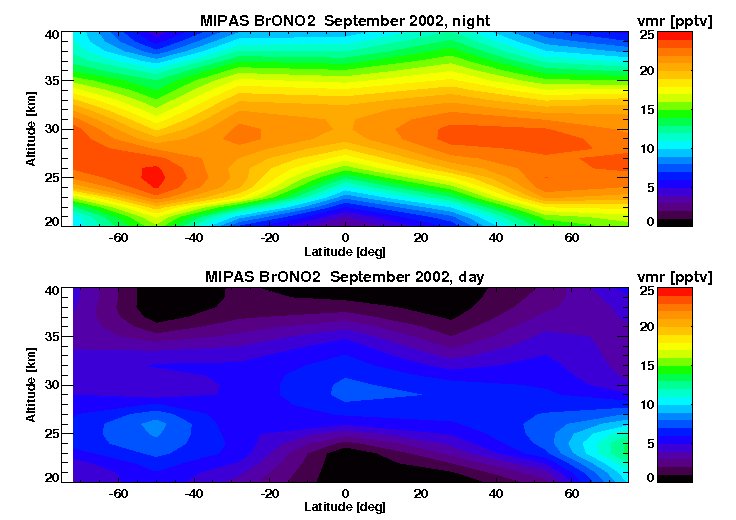First observations of bromine nitrate in the atmosphere

Global stratospheric distribution of bromine nitrate (BrONO2) as measured for the first time by MIPAS/Envisat during night (top) and during day (bottom) in September 2002.
In spite of its much smaller concentrations, bromine is actually, after chlorine, the second most important halogen species destroying ozone in the stratosphere. Against the background of abating levels of chlorine in the stratosphere (e.g. from man-made CFCs), bromine will become more and more important in the cycles of stratospheric ozone chemistry.
One reason for its higher potential for ozone depletion per atom (by about a factor of 60) compared to chlorine is the considerably faster photolysis of the reservoir species bromine nitrate (BrONO2) compared to that of chlorine nitrate (ClONO2). Captured in these reservoirs, the halogens do not affect stratospheric ozone. In particular, during night BrONO2 is by far the most abundant bromine species and even during day it is second directly after BrO.
While BrO has first been detected in the atmosphere already 20 years ago and ClONO2 even 30 years ago, BrONO2 has not been observed until recently when, in mid-2008, its spectral fingerprint has been discovered in high-resolved infrared spectra measured by the Michelson Interferometer for Passive Atmospheric Sounding (MIPAS) on ENVISAT.
The BrONO2 signature is rather weak so that more than 1000 spectra per latitude bin had to be averaged over the period of one month, which were then analysed by detailed radiative transfer calculations. The position of the spectral feature, its day/night variation and the derived atmospheric concentrations leave no doubt that at last BrONO2 was detected.
By comparing the novel MIPAS BrONO2 dataset with model calculations including the complementary BrO measurements by SCIAMACHY on ENVISAT our general understanding of stratospheric bromine chemistry was clearly confirmed. Further, these new observations enable an independent estimation of the total amount of inorganic bromine in the stratosphere. This is important to understand the origins of stratospheric bromine. It is well known that long-lived organic bromine compounds are released in the troposphere by natural and anthropogenic sources which then are transported into the stratosphere. However, recent measurements indicate that the known sources are not sufficient to explain the stratospheric bromine loading: additional sources - like short-lived organic compounds - or direct injection of inorganic bromine into the stratosphere might be more important than previously thought. Thus, the new MIPAS observations help to constrain the sources of inorganic bromine and, therefore, serve to improve simulations of stratospheric ozone chemistry and its coupling with climate in the future.
Reference: http://www.atmos-chem-phys.net/9/1735/2009/acp-9-1735-2009.html
